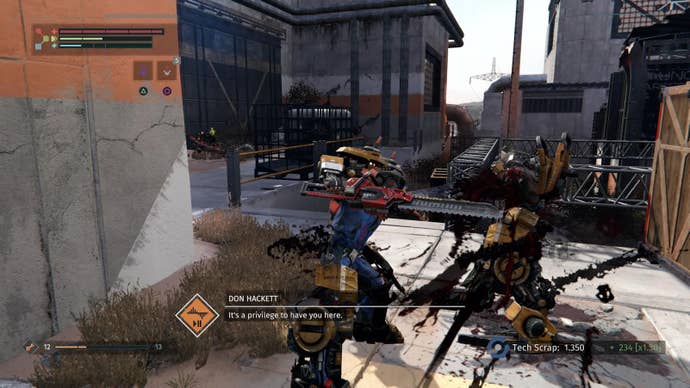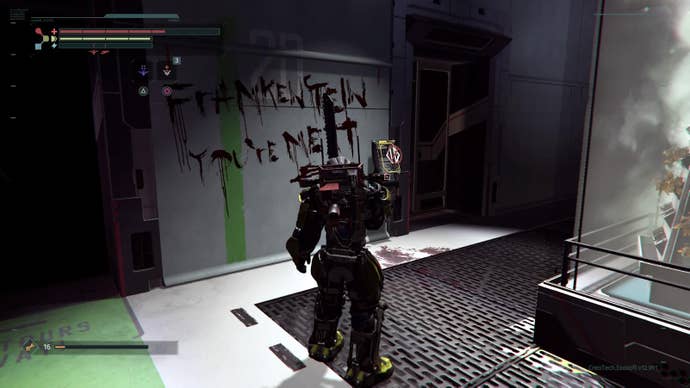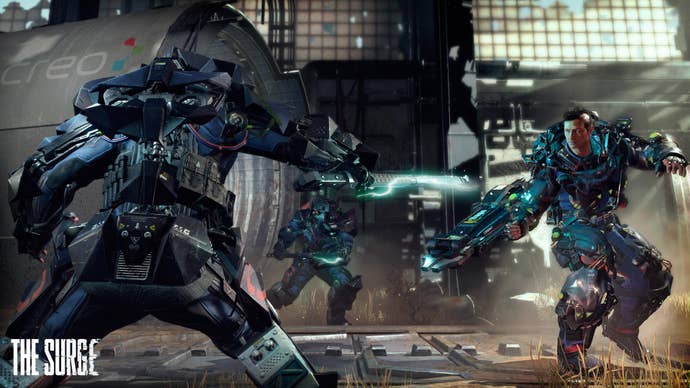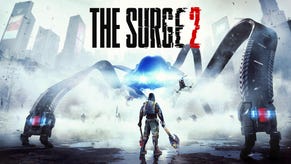The Surge Review
The imperfect next step.
This article first appeared on USgamer, a partner publication of VG247. Some content, such as this article, has been migrated to VG247 for posterity after USgamer's closure - but it has not been edited or further vetted by the VG247 team.
I wish I could start this review with a clever metaphor or an amusing anecdote. I mean, I like reviews that start that way, personally; the kind that opens with a "this wacky thing happened during this boss fight and that sums up how X game will be loved and hated." Yes, it can get a little lazy if over-used, but you can’t say that a game being reviewed professionally that has those kind of moments is lifeless or bland. They at least have an instance that someone can go back to it and chuckle, and that says something. The Surge doesn’t have those things. I suppose not having a catchy opener is its metaphor. It’s a competent, well-intentioned, finely-built video game of killing things, but not such a great first impression.

I don’t mean to rag on developer Deck 13’s sophomore Soulslike too hastily, because it’s definitely a step forward from their previous Dark Souls homage, Lords of the Fallen. But while that game traded a sense of atmosphere and place for bombast, The Surge cobbles together a larger handful of influences from other games and genres so much that it never finds its own narrative or mechanical identity.
Take the setup: You play as Warren, a wheelchair-bound man living in the near future whom joins the mega corporation Creo. As humanity has ravaged the Earth for millennia, Creo is planning on launching probes into space to fix various surface and atmospheric Earth problems, while also grafting Warren to an elaborate, upgradeable exo-suit that will help him walk again. Warren blacks out on his way to his work site, and wakes up in a pile of rubble amidst worker robots and his colleagues whom have all gone insane. Not a bad lead in, really, but by no means original. The mystery of what really happened with the work site and how it all twists by the end is meant to be the carrot that drives you to see the credits roll, but it’s become standard action game fare at this point, and wasn’t enough to keep my interest by itself.
But this is certainly an action game, one heavily focused on the melee side of things, and this is the first great departure from some of The Surge’s more obvious influences while still keeping a stranglehold on others. Warren isn’t a blank slate insomuch as that you can’t go through a character creator to mold him, but he’s something of a combat agnostic. The game gives you a choice between being a light, mobile attacker or more of a heavy tank, but these are merely suggestions because you can use and equip whatever you want. There’s no immediate ranged attack option at the beginning of the game, and though you acquire an ability to do so about a third or so of the way in, this was never a viable option for battle, merely to pull enemies away from packs so as to not juggle too many at once. The Surge really wants you to be in your foes’ faces, and I was a little let down by the lack of character build options.

This was by design, though, because plinking enemies from afar would step on the game’s main selling point, which is fighting and gear farming. While there is a small variety of robotic enemies in the game ranging from flying drones to tri-pedal "attack dog" –types, the vast majority of adversaries are human, and each of their body parts can be targeted by flicking the right analogue stick. By attacking an armored limb, a downed foe has the chance to drop a schematic for that particular piece of armor they were wearing. On the flip side, hitting an unarmored part of their body will kill them quickly. Strangely, this is also somewhat randomized; certain enemies you’ll encounter over and over again will always have the same weak points, but others may change where these are located every time you reset the field by hitting a medical bay to heal.
When first encountering new enemies it’s fun to grind their armor set schematics as a way to learn their behaviors, which trains you to kill them in efficient ways when you just want to mow through a few. It winds up being a bad reward loop, however, when you realize that the game is bafflingly stingy with doling out the materials needed to actually make anything. All drops in the game are uncommon, and continuing to target enemy armor that you’ve already acquired rarely yields the necessary components to making anything.
It’s certainly understandable that the devs don’t want overpowered Warrens running around sooner than they’d like, so gating weapon upgrade materials further into the story makes sense. But it’s frustrating to go through the trouble of getting a full set of a certain armor type and then go through the vast majority of the game with the same helmet you made in the first hour because you couldn’t scrounge up enough stuff to make a new one. Warren’s status screen told me that there are armor set bonuses. I never had the opportunity to find out what they were.
The combat itself demands a very measured approach to everything. It’s becoming a cliché to say that every enemy is a threat in a game like this, but this is especially true for The Surge due to Warren’s own glacial movement. Even in its earliest moments when he’s packing a busted lead pipe, Warren swings weapons very slowly, which only gets worse as he equips heavier gear. I found that weapon choice can force a certain armor loadout – if I wanted to use a large cleaver that I scored from a killed boss, I needed to equip the heaviest armor I could find to soak up damage because I would certainly take a hit or two mid-attack.
Instead of two different strengths of attacks, the shoulder buttons let you alternate between horizontal and vertical swings which build combos that differ by the weapon, but they all move at a similar speed to previous attacks. Even with the lightest weapons, then, you really need to mean every movement you make and be thoughtful with your aggression. At first, it’s very cumbersome and clunky, and it really doesn’t get that much better with time. Given the enemy armor breaking and this more precise way of attacking, having multiple enemies on-screen gets to be a real hassle since whatever limb you’re targeting on one attacker won’t be the same weak point on another. It quickly becomes more frustrating than exhilarating. But single enemy combat is fun if you can keep it that way provided you can maintain a level head and react to enemy tells fast enough.

Equally cumbersome is the world the game inhabits. The Surge takes place in discrete levels that are large enough to fold back in on themselves like any good exploration-based action game should. For the most part, it does a really good job of that, in fact. Running across locked doors and partitioned rooms that require special keys happens with fair frequency to entice you to make return trips if you have the interest in exploring. Shortcuts give that requisite rush of endorphins when you unlock them.
Where things stumble is figuring out just what you should be doing at any given time. The medical bays where Warren heals have a communication device that gives you direction to your next objective in very broad strokes, so the game tends to be very hands-off with your exploring. On the one hand, this is some nice nonlinearity. On the other, it’s easy to stare at your screen for a while wondering just what the hell you should be doing.
Late in the game after killing a boss, I was told repeatedly to take his identity to open up security doors. Silly me, killing this guy alone didn’t do it, so I fumbled around the small environment for an extra 20 minutes in circles until I accidently crashed through a wall in a med bay that granted me an exo-rig upgrade. Surprise, I also have access to locked doors now. I love that Deck 13 chose not to be explicit with their direction, but since a lot of the environments can feel a little redundant, it became a little challenging to parse out what I needed to do next and where I should go to do it.

If you can say one thing for The Surge, it’s that everything is just almost there. The combat is weighty, but can be satisfying. The exploration awkward, but serpentine in the best way.
Character progression, though, is what The Surge really gets right. In a refreshing change of pace from agonizing over builds and stat allocation, the game employs a fairly elegant augmentation system. Everything essentially revolves around leveling your exo-suit; spend experience on it ("scrap" in this one) and you’ll be granted core points. Equipping armor costs core points, as do implants that range from displaying enemy life meters to expanding your own health.
Upgraded rigs that are found throughout the game open up extra implant slots, as do hitting certain level thresholds. These rig levels never affect your stats, though many of the implants scale with them, so it can be worth, say, stacking two health upgrades into your loadout and then another implant that artificially grants extra rig levels for a nice hit point boost. Weapon types get stronger the more you use them along with the requisite upgrade paths, so other implants may add further proficiency for attack buffs. It’s never as complicated as it looks at first glance, and juggling things around and swapping out upgrades is painless.
After reading all of this, it might be a little weird for me to say that The Surge won me over by the end. Maybe it’s just too hard to fault Deck 13 for their sincerest form of flattery. These guys tried really hard to make their own Dark Souls with Lords of the Fallen, and tried even harder to evolve the form with The Surge. It’s sad that it almost feels like The Surge’s early stages almost felt like design-by-committee with their blandness, but there’s a heart to this game, I think, and fans of Soulslikes –or whatever we settle on calling them over time—will find something to love about this game like I have. In a year busy with games like this, it’s nice to see that there’s still a standard of quality that they’re holding to, even if, sadly, The Surge finds itself on the lower end of that spectrum.
Lasting AppealOne run through of the game should last under 30 hours for most, and that will probably be enough for them. There are enough nooks and crannies and locked doors to dig back through for those inclined, and plenty of weapon styles to experiment with, but that’s about where the depth stops.
SoundA bit more atmospheric than their earlier work, but still a constant drone of ambient sound. This isn’t a game about quiet, tense terror, even though it seems to try to be from time to time.
VisualsNot pretty by any means, but not offensive, The Surge has a workmanlike quality to its graphics. The rubble in the early levels looks nice, but the dark corridors of the mid to late game get old fast. The HUD can get a bit obtrusive with a lot of enemies on-screen if you happen to grab an audio note at the wrong time. Maybe turn those subtitles off.
ConclusionThe Surge gives a lousy first impression with it bland sci-fi setting and grab bag of obvious influences. Given time, though, there’s an unrefined gem in here for those willing to put up with its quirks. If this is Deck 13’s next step to building something truly great, it’s a solid, if flawed one.







